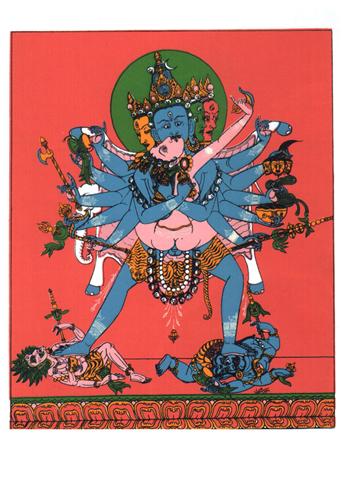The Tantric Approach
10 Apr
Tantra, that ubiquitous term is often used and misused in equal measures. Unfortunate for some, Tantra is not about sex per se. However, there is a lot of sensual, sexual and somewhat primal references and imagery in Tantra. This is particularly so in Buddhist Tantra and I am not going to go into Hindu Tantra because it is something altogether quite different. We are very fortunate because Buddha Shakyamuni taught Tantric teachings and that is not something to be taken lightly as there are only a small handful of Buddhas that will do this. The next Buddha to come, Maitreya will not teach Tantra.
The Tantric path is often described in many ways but the ones that are popularly used is taking the fruit as the path and transmutation of poison.
Taking the fruit as the path
Instead of practicing all the necessary steps and disciplines needed to slowly become a Buddha, we choose to become a Buddha right now. We visualise ourselves as the Buddha by acting, talking and thinking like the Buddha. How this is possible is through positive affirmation of ourselves as the Buddha. The formal practice is through a daily Sadhanic practice that contain specific rituals and mantras designed to break down our concept of ego and reconstitute it as the Buddha or in Tibetan – Yidam. This is called deity yoga and the deity/yidam is best assigned by our Lama who has already assessed what is most suited to our type of mind.
Hence, there are countless yidams in all shapes, sizes and levels of practice to suit a multitude of minds. Those that are the highest Tantric yoga class of yidams are basically Buddhas manifested along with a meditational practice to bring one directly and swiftly towards Enlightenment. An example of such a yidam is Vajrayogini and this is specifically recommended by Rinpoche to suit our modern lifestyle and mindset. However, there are specific requirements to be met before one engage in such Tantric practices. The main requirements are having gone through a rite of initiation. (Initiation is huge topic onto itself)
Transmutation of Poison
Poison for the mind is likened to ego and its attendant delusions. Tantra with its special methods have the ability to transmute poison-like delusions into enlightened qualities of a Buddha. Under the right circumstances, delusions can be engaged and transformed into spiritual practice to slowly reduce and eventually remove the ego. Hence, the meditation process is very much like the flame of a lit candle that uses and burns the wax of the candle away. Hence, Rinpoche recommends his students to spend as much as they can on their altars, by making offerings and acquiring the best statues and offering fine vessels. Conventionally, it seemed to be encouraging attachment towards objects of physical beauty but in actuality, the students are creating merits through the power of the object – the Buddha and the powerful motivation that goes along with the offering. Hence, using the delusion of attachment to beauty, one can offer it up to the Buddha and gain liberation.
Rinpoche also tells some of us to indulge in the things that we normally enjoy and don't think it is wrong. Instead of thinking it is wrong, we just change the motivation behind the indulgence. We can enjoy the cars that we wish to buy, the money that we wish to earn, the holidays that we wish to go and the position we wish to attain. So what is Rinpoche telling us is to add a selfless/Dharmic dimension to our motivation. This is of course very basic but is a start to a whole practice where we visualise ourselves as the yidam and have all the people in our immediate surroundings as divine beings and the environment itself as the spiritual abode of the yidam. Hence, by way of Tantra, we can make every moment we breathe, a moment of merit that can propel us towards Enlightenment.
(The deity shown in the picture is called Heruka Chakrasamvara and he represents the transmutation of desirous attachment into Enlightenment.)






“We are very fortunate because Buddha Shakyamuni taught Tantric teachings…”
So, how does one counter the allegation that Buddhist Tantra originated/derived from the Hindu counterpart, being a ‘later development’? Even some Buddhists think so…What does Rinpoche say on this?
Dear Peter,
The Tantric deities are not derived from the Hinduism and the motivation and meditations are vastly different. The Buddha had to use conventions that were familiar during his time. For example, karma, the cycle of rebirth and others are not something original, it was borrowed from Hinduism. But the basis and motivation are completely different.
Thanks for this interesting post. I appreciate learning more about Tantric Buddhism, since there’s so much superficial crap out there about it.
I just found your blog through another blog, and look forward to reading more. Best, Nathan
You are welcome Nathan and nice knowing you. Nice interesting blog you have over there too.
Tantra is a system that efficiently combines science with spirituality, revealing the mysteries of Creation and of the Universe that appear in light of this system being structured holographically, the part being integrated in the Whole and the Whole being reflected in each of its parts. Tantra uses the study of the fundamental laws for the study of phenomena and practical knowledge in order to replace rules and dogma. Tantra is based only on direct practical knowledge. For this reason, the Tantric system is a solution for the modern man to get out of the state of anxiety regarding life, a state that makes him prefer indirect experience, experience through different means and formalities, as opposed to direct experience.
http://www.indiasfamousastrologer.com
tantra mantra
I am not sure if you can read this but Buddhist Tantra is quite different from Hindu Tantra. Although superficially resembling each other with the mantra, mandalas and divinities but the purpose and the motivation is altogether very different.